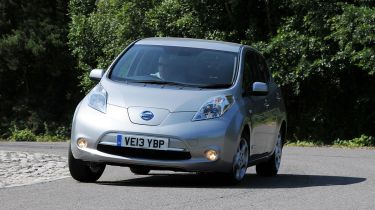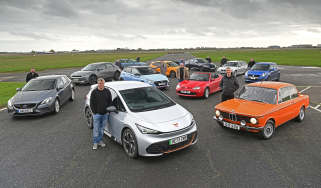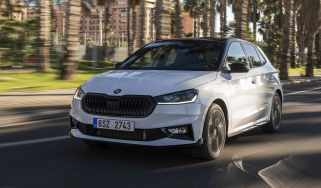Nissan Leaf Visia
It's a bigger car than the ZOE, so you get more passenger space and a bigger boot. But the Renault’s steering, handling and ride are all a fraction better than the Leaf’s. Plus, Visia trim doesn’t get all of the revised Leaf’s technology upgrades, and so won’t have the real-world range of more expensive models.
The Nissan Leaf leads the way as the world’s best-selling electric car and, although this is only a small-volume niche of the car market, it outsells its closest rival, the Mitsubishi i-MiEV, by a ratio of nearly two to one.
But Nissan hasn’t rested on its laurels, and this revised version features more than 100 subtle updates that come as a result of feedback from existing customers. You’d have to study the new British-built Leaf pretty hard to spot the visual changes, though. They largely centre around a revised front bumper, but there are now three trim levels to choose from: Visia, Acenta and Tekna. What’s more, you have two choices when it comes to purchasing, as you can either buy the car outright, or go with a Renault-style monthly battery hire scheme. Take this option, and you can get the entry-level Visia Flex for £15,990 – which is only £795 more than the ZOE Dynamique Zen.
Used - available now

2024 Cupra
Formentor
38,006 milesAutomaticPetrol1.5L
Cash £19,676
2023 Vauxhall
Mokka Electric
11,234 milesAutomaticElectric
Cash £13,697
2020 BMW
2 Series Convertible
60,728 milesAutomaticPetrol1.5L
Cash £12,797
2023 FORD
TRANSIT CUSTOM
45,332 milesManualDiesel2.0L
Cash £27,954However, this basic version of the Leaf does without a couple of the key technical upgrades. Acenta and Tekna models have a new heat exchanger that reduces load on the battery by heating and cooling the car more efficiently. They also feature two drive modes: D for conventional drive and B for extra regenerative braking. Neither of these upgrades feature on the entry-level Visia, and while the official range is still 124 miles (up from a pre-facelift 109 miles), Nissan admits that in real-world conditions the Visia won’t match the more expensive models.
However, Nissan has reduced the Leaf’s kerbweight, meaning it’s just 57kg heavier than the smaller ZOE. Combine this with a 107bhp electric motor – that’s an extra 20bhp over the Renault – and the Leaf can sprint from 0-60mph in 10.1 seconds, 1.5 seconds quicker than its all-electric rival.
Inside, darker cabin materials are a response to customer demand for a more user-friendly interior, while the seats are more supportive, too. Overall, the driving position is more comfortable than the Renault’s, while the smart central screen and better plastics give it the edge over the Yaris.
But despite changes to the suspension, the Leaf still feels heavy and unresponsive in corners. The light steering and tendency for the front tyres to lose grip are disappointing, plus it’s hard to brake progressively.
Moving the battery charger to the nose has increased boot volume by 40 litres to 370 litres, while the three-pin plug gives you more charging options than you get with the ZOE. The Leaf is now cheaper than ever, so it’s easy to see Nissan continuing to dominate the EV sales charts. But is it better than the ZOE?



